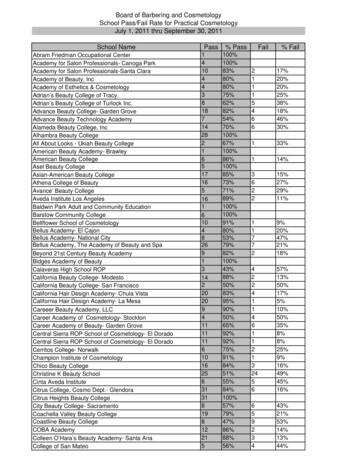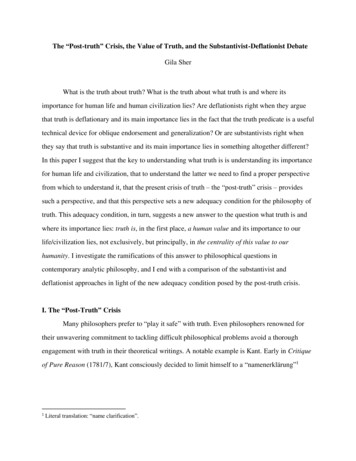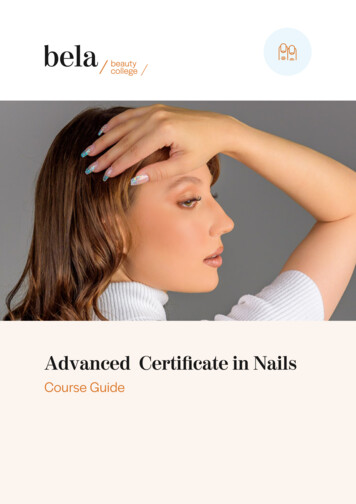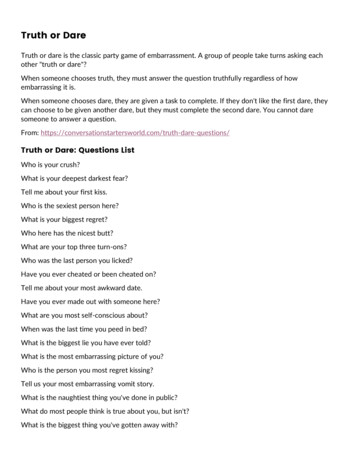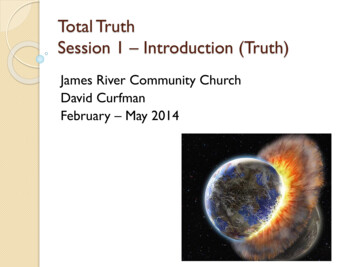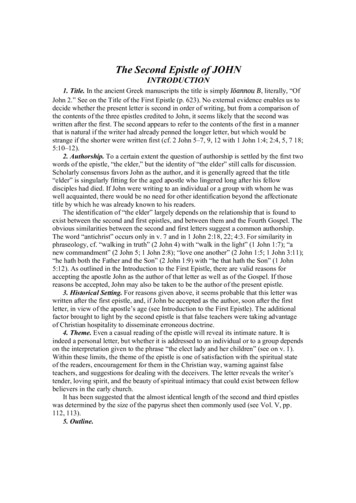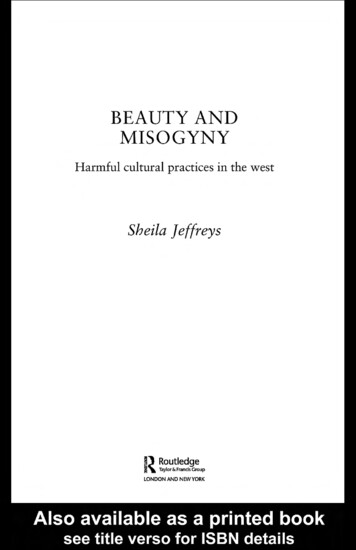
Transcription
“THE REAL TRUTH ABOUT BEAUTY: A GLOBAL REPORT”Findings of the Global Study on Women, Beauty and Well-BeingSeptember 2004Dr. Nancy Etcoff – Harvard UniversityDr. Susie Orbach – London School of EconomicsDr. Jennifer Scott – StrategyOneHeidi D’Agostino – StrategyOneCommissioned by Dove, a Unilever Beauty Brand“‘Beauty is truth, truth beauty’ -- that is allYe know on earth, and all ye need to know.”John Keats – Ode on a Grecian Urn1
ABOUT THE STUDYThe Real Truth About Beauty study was commissioned by Dove, one of Unilever’s largestbeauty brands, to further the global understanding of women, beauty and well-being – and therelationship between them. It had its genesis in a growing concern that portrayals of femalebeauty in popular culture were helping to perpetuate an idea of beauty that was neither authenticnor attainable. Dove was concerned that this limited portrayal of beauty was preventing womenfrom recognizing and enjoying beauty in themselves and others. The company was also awarethat – in a world where female beauty is highly valued – this situation could also impactwomen’s well-being, happiness and self-esteem.Dove’s mission, in commissioning The Real Truth About Beauty study, was to exploreempirically what beauty means to women today and why that is. Further, Dove wanted the studyto assess whether it was possible to talk and think about female beauty in ways that were moreauthentic, satisfying and empowering.The Real Truth About Beauty findings detailed in this White Paper are based on quantitative datacollected from a global study of 3,200 women, aged 18 to 64. StrategyOne – an applied researchfirm based in New York – managed the study in collaboration with Dr. Nancy Etcoff andMassachusetts General Hospital - Harvard University, and with the expert consultation of Dr.Susie Orbach of the London School of Economics. The survey was fielded between February 27and March 26, 2004, using the field services of MORI International. Interviews were conductedacross ten countries: the U.S., Canada, Great Britain, Italy, France, Portugal, Netherlands, Brazil,Argentina and Japan. The survey has a margin of error of 1.7 percentage points among the totalsample of 3,200.To inform the structure and content of the study, Dove first commissioned a global literaturereview, which examined existing research and writing on beauty, appearance and self-worth.This review was conducted by the specialist secondary research and media analysis group ofStrategyOne. It was designed to review current public knowledge on the topic and to isolate anygaps that might exist in the discourse. The review scanned materials available in 22 languagesfrom 118 countries. It tapped multiple databases provided through the National Library ofMedicine and PubMed, as well as the Reuters and Dow Jones newswires and the Factiva Newsdatabase. It may be accessed on the Internet at: www.campaignforrealbeauty.com. TheLiterature Review is supplemented by ongoing quarterly updates based on analysis of the latestdata and information gathered from global databases.2
FOREWORD BY SYLVIA LAGNADO - GLOBAL BRAND DIRECTOR, DOVEThis powerful study was born out of a desire to talk to women around the world about femalebeauty. Dove knows that the relationship women have with beauty is complex: it can bepowerful and inspiring, but elusive and frustrating as well. We sponsored this study in order toprobe more deeply into this intricate relationship. Dove wanted to understand how womendefine beauty; how satisfied they are with their beauty; how they feel about female beauty’sportrayal in society; and, how beauty affects their well-being. This work is groundbreakingbecause no one had undertaken a comprehensive study of this nature before. And, the results aretruly enlightening.Dove wants more women to feel that beauty is within their reach and this study is instrumental inshowing us how to achieve this goal. The results demonstrate the need to present a widerdefinition of beauty than is currently available to women – regardless of where they live. Bydoing this, Dove can not only help women feel beautiful every day, we can help them lead moresatisfied lives.Dove adopted a rigorous academic approach to this research. It commissioned the services ofestablished applied research companies, StrategyOne and MORI International, to ensure that theimplementation of the study met criteria and codes of conduct established by global researchassociations, including ICC/ESOMAR and the American Council of Research Organizations(ACRO). In addition, Dove utilized leading independent thinkers and academic institutions forexpert guidance and support for the study hypotheses, quantitative research design, and dataanalysis. Finally, Dove ensured that the study itself contained no reference to the brand or itsparent, Unilever, and participants remained unaware of their sponsorship of the study.3
FOREWORD BY DR. NANCY ETCOFF - HARVARD UNIVERSITYIn 1913, Webster’s dictionary defined beauty as “properties pleasing the eye, the ear, theintellect, the aesthetic faculty or the moral sense.” But in 2004, the default definition of beautyhas shriveled pitifully. The contributions of the ear, the intellect, the broader aesthetic faculty orthe moral sensibilities are gone. Beauty is visual; in fact, it is the same visual – the eye poppingfeatures and stunning proportions of a few hand picked beauty icons. No wonder many peopleturned away from beauty. In the 1980s and 1990s beauty fell out of academic discourse. Somepeople waved it away, denying its reality or power. But beauty never went away and it is time toreclaim it.As we used to know, beauty is so much more. The Real Truth About Beauty study on women,beauty and well-being is a landmark, a revolutionary step forward in reclaiming beauty and reexamining it with a 21st century point of view. It realizes that beauty is never going away andthat it has enormous power. It knows that beauty should not be reduced to a political or culturalproblem but understood as a basic human pleasure.This study used rigorous methodology to canvass women in many corners of the world, allowingthem to deconstruct and reconstruct their notions of beauty. The study does not suggest thatwomen are self-loathing or in despair or mere victims. Far from it. But they do not feel thepower and pride of beauty, either. Only the minority of women see themselves as above averagein appearance, and only 2% claim to be beautiful. It is important to put this finding in context.Studies of well-being and self esteem show that people in western cultures (but not East Asia)rate themselves as better than average on everything from kindness, intelligence, and popularityto their skills as a mate or parent or as an employee or a driver. “Average” is an unusually lowrating. Indeed, the study shows that women are less satisfied with their beauty than with almostevery other dimension of life except their financial success. There is enormous room forimprovement.The Real Truth About Beauty study makes it clear that it is time to lift the quota system onimages of beauty. The diversity of human beauty has been strained through a sieve of culture,status, power and money and what has emerged is a narrow sliver of the full panorama of humanvisual splendor. Beauty is diverse and the human eye thrills to new pleasures and fresh sourcesof inspiration. Ethereal weightlessness and Nordic features are not its only incarnation. AsDarwin wrote, “If all our women were to become as beautiful as the Venus de Medici we shouldfor a time be charmed but we should soon wish for variety and as soon as we had obtainedvariety we should wish to see certain characteristics in our women a little exaggerated beyondthe then existing common standard.”Let the discussions and debates begin and let us reclaim and rejoice in authentic, diverse humanbeauty once again.4
FOREWORD BY DR. SUSIE ORBACH – THE LONDON SCHOOL OF ECONOMICSWomen want to see the idea of beauty expanded. As this ten country survey so clearly shows,women see emotional qualities, character and individuality as equally expressive of beauty as thenarrow physical aspects of beauty that currently dominate popular culture.To be sure, women want to be physically attractive and they want to be perceived as such. Theirlooks are important to how they feel about themselves, how they regard beauty in themselves andin others. But at the heart of this study is a result which is highly significant: Women regardbeing beautiful as the result of qualities and circumstance: being loved, being engaged inactivities that one wants to do, having a close relationship, being happy, being kind, havingconfidence, exuding dignity and humor. Women, who are like this, look beautiful. They arebeautiful.When it comes to strictly physical attributes, the images of manufactured femininity are rejectedas being too narrow, as inauthentic and as insufficient. The great majority of women wantbroader definitions of how women’s physical beauty is visually represented. Seventy fivepercent of women in the study would like to see considerably more diversity in the images ofbeauty. They want to see women of different shapes, they want to see women of varying sizesand they want a broader range of ages in the pictures of women than those who, at present,saturate our visual field.These results are in a sense, no surprise at all. The last fifty years have witnessed an interestingparadox. Beauty – as an idea and an ideal – has moved away from being the exclusive provinceof the Hollywood dream factory, of fashion models and the young bride, to become an essentialattribute to which women of all ages need to pay heed. But at the same time that women of allages and classes want to claim beauty for themselves, there has been an insidious narrowing ofthe beauty aesthetic to a limited physical type – thin, tall – which inevitably excludes millionsand millions of women. The conjunction between democratizing the idea of beauty and thelimiting of what constitutes the ideal of beauty has caused considerable anguish to women –young to old – who strive to find in themselves the means to meet those aesthetic values whichhave come to make up what we regard as beautiful.Women’s interest in and preoccupation with beauty, is not some easily dismissed concern. Thisstudy shows conclusively that women now judge beauty as important and even crucial as theynavigate today’s world. In attempting to democratize and make accessible to all the idea ofbeauty, women are eager to see a redefinition and expansion of the ideals, along the lines theysee it and away from the limiting, narrowed and restricted body shapes and sizes we see inmoving images and in print.5
The overwhelming majority of women (despite the popularity of Extreme Makeover ) do notwish to expose themselves to the surgeon’s scalpel. But neither do they wish to be excludedbecause they fail to find their beauty reflected in the images which bombard them, on average, in2000 advertisements per week.What women in this study tell us is that a sense of legitimacy and respect is wrapped up withbeauty in today’s world. Whether this sentiment dismays or delights us, it poses a seriouschallenge. And it is this in the first instance: For the idea of beauty to become truly democraticand inclusive, then beauty itself must be revitalized to reflect women in their beauty as theyreally are rather than as portrayed in the current fictions that dominate our visual culture. Withsuch fictions removed, the many hours of anguish, spent in self criticism, or in the attempt toreshape themselves so that they do in some ways resemble the ideal, have a chance to be freed upand find expression in the many other desires and ambitions that women hold.6
STUDY METHODOLOGYThe Real Truth About Beauty study was managed by StrategyOne – a specialist applied researchfirm based in New York – in conjunction with Dr. Nancy Etcoff of Harvard University and Dr.Susie Orbach of the London School of Economics. The study consisted of a 3,200-respondenttelephone survey, conducted among women aged 18 to 64 in ten countries. Each interviewlasted between 20 and 25 minutes (depending on translation length) and respondents wereinterviewed by native speakers in their own language.Interviews were conducted in each of the following countries: U.S., Canada, Great Britain, Italy,France, Portugal, Netherlands, Brazil, Argentina and Japan. Three hundred (300) interviews wereconducted in each country, except the U.S., where 500 interviews were conducted. This was toallow for a more robust analysis of the U.S. data.Interviewing took place between February 27 and March 26, 2004 using the telephone fieldservices of MORI International based in London. MORI is one of the most reputable fieldingservices in the world, with a global scope and significant in-country resources for the effectiveimplementation of studies across a wide variety of languages, dialects and cultures. The surveywas designed in English and translated into seven other languages by MORI translators. Localcountry representatives of both MORI and Dove reviewed the translations in detail to ensure thatthey were as consistent as possible with the original – while allowing for local nuances.The data were weighted for each country to ensure accurate representation by age, marital status,income/social class, ethnicity and region. The margin of sampling error at the 95% level ofconfidence is 1.7 for total respondents (3,200), 4.4 for the U.S. (sample of 500), and 5.7 forall other countries (sample of 300). This means that, in 95 times out of a hundred, when asample of this size and composition is drawn , findings will not differ by more than 1.7percentage points in either direction for the total sample, and plus or minus 5.7 percentage pointswithin each country (plus or minus 4.4 percentage points for the U.S.). This margin of error issmall – particularly at the global level – making the data highly reliable.7
FINDINGS8
WOMEN’S RELATIONSHIP TO THEIR OWN BEAUTYThe Real Truth About Beauty study began by exploring to what extent women perceive andexperience themselves as beautiful, and the reasons why. Specifically, the study tried todetermine: how comfortable women are with using the word to describe themselves; their levelof satisfaction with their own beauty; its impact on their sense of well-being; and, how importantit is to them.The initial part of the study specifically asked women to reflect on their own beauty. It was onlylater in the study that women were asked to reflect on beauty as a concept or in relation to others.Thus, at the outset of the study – before women had a sense of the subject matter of theinvestigation – the objective was to obtain as accurate an understanding as possible of women’srelationship with their own beauty, unmediated by ideals or stimulus that encouraged deeperreflection on the concept.Ownership of the Word “Beautiful”Study data reveal that “beautiful” is not a word women willingly associate with themselves. Inthe study, women were given a list consisting only of positive or neutral adjectives to describetheir looks (including; “natural,” “average,” “beautiful,” “sexy” and “gorgeous”) and asked tochoose the one they felt most comfortable with.By an overwhelming majority, women around the world are most comfortable using the wordsnatural (31%) or average (29%) to describe their looks. Only 2% of women around the world choose beautiful to describe their looks, fewereven than choose “attractive” (9%), “feminine” (8%), “good-looking” (7%) or “cute”(7%).Analysis reveals that this lack of identification with “beautiful” holds across all age groups, withonly 4% of 18-29 year-olds choosing “beautiful” as a word to describe their looks.9
Self-descriptors for one’s looksTotal cated1%Sexy1%StunningGorgeous1%0%0%20%40%60%C1 – Which ONE of the following words, if any, would you be most comfortable using todescribe the way you look?80%100%Excludes none of these,don’t know and refusedA country-by-country analysis reveals that there are interesting distinctions between the twomost popular descriptors of “average” and “natural.” “Natural” is the descriptor of choiceamong Canadian, Italian, French, Argentinean and Japanese women, while Brazilian,Portuguese, British and Dutch women are most likely to describe themselves as “average.” 6% of Brazilian women choose “beautiful” to describe themselves – the highest numberamong all countries studied.10
Self-descriptors for one’s 0%C1 – Which ONE of the following words, if any, would you be most comfortable using todescribe the way you look?Excludes none of these,don’t know and refusedRanked on totalrespondentsDeeper probing on this issue revealed that four in ten women around the world strongly agree(8, 9, or 10 on a 10-point scale) that they do not feel comfortable describing themselves asbeautiful.NOTE: Throughout this study, we have used “strongly agree” data (top 3 box), meaningthat women had to select 8, 9, or 10 on a 10-point scale where 1 was “completelydisagree” and 10 was “completely agree.” This is in keeping with research convention.From the perspective of the lay reader, it is important to remember that - in all cases “strongly agree” represents very firmly held beliefs—not simple accord.Thus, “beauty” is not only a word that women are very unlikely to choose to describe their looks;it is also one which many actually feel “uncomfortable” using to describe themselves. This levelof “discomfort” illustrates the degree to which women have become distanced from today’s ideaof female beauty. Importantly, women feel this way regardless of age. Thus 40% of 18 to 29 year-oldsstrongly agree that they do not feel comfortable describing themselves as beautiful,with 43% of 30 to 44 year-olds and 42% of 45 to 64 year-olds also feeling this way. A country-by-country comparison reveals that women from Great Britain are morelikely than women from other countries to feel uncomfortable describing themselvesas beautiful, followed by women from Argentina, Italy and the U.S.11
Discomfort in describing self as beautifulTotal Respondents“I do not feel comfortable describing myself as beautiful”100%80%60%42%40%17%20%0%Strongly agree (top 3 box)Strongly disagree (bottom 3 box)10 pt. scaleC57 - Now, I am going to read you a list of statements, and I’d like you to tell me to whatextent you agree or disagree with each. Please use a 10-point scale where 1 means you“Completely disagree” and 10 means you “Completely agree”.Discomfort in describing self as beautiful“I do not feel comfortable describing myself as beautiful”100%Strongly anrgenti naArazilBPortugaletherl andsNFrancelyItaKUanadaCUSA0%C57 - Now, I am going to read you a list of statements, and I’d like you to tell me to whatextent you agree or disagree with each. Please use a 10-point scale where 1 means you“Completely disagree” and 10 means you “Completely agree”.Top 3 box of 10 pt. scale12
Self-Evaluations of Beauty and Physical AppearanceThe Real Truth About Beauty study went on to conduct an assessment of how women evaluatetheir own beauty. Throughout this exploration, women were asked to evaluate both their beautyand their physical attractiveness. This was partly to determine how women assess themselves,and partly to discern whether women evaluate their “beauty” any differently from their “physicalattractiveness.” While similar assessments of both would not confirm a causal connection (i.e.,beauty is based solely on physical appearance), it would suggest that women think about the twoin similar ways, seeing them as having a great deal of overlap and perhaps as beinginterchangeable.Results show that, overall, women do not rate their own “beauty” and their “physicalattractiveness” differently across various measures (such as evaluation and satisfaction). Thusthe two concepts appear – in these respects – interchangeable.Data show that the vast majority of women rate themselves “average” in terms of their “beauty”and their “physical attractiveness.” Almost three-quarters of women (72%) rate their beauty “average” and 69% rate theirphysical attractiveness “average.” Overall, 13% see themselves as somewhat less or much less beautiful or physicallyattractive than others. 16% of all women think of themselves as “somewhat more” or “much more” physicallyattractive than others.Apart from the similarity in the ratings across both concepts, the very substantial number ofrespondents opting for “average,” indicates that women prefer not to distinguish themselves fromother women in terms of either their beauty or physical attractiveness.13
Comparison to other womenbeauty – physical attractivenessTotal RespondentsBeautiful12%Physically attractive15%0%72%69%20%Much/somewhat more than average40%Average60%13%3%13%3%80%Much/somewhat less than average100%DK/RefusedC4 – Compared to other women, do you think you are ? C39 – Compared toother women, do you think you are ?Country comparisons reveal that women in Japan are significantly more likely to rate theirbeauty and their physical attractiveness poorly compared to other women. They are significantlymore likely to think of themselves as “somewhat less” or “much less” beautiful or physicallyattractive. Indications from numerous other studies as comparative subjects among the Japaneseare that these relatively depressed scores for Japan are reflective of a broad and consistentcultural trend.14
Comparing beauty to other therlands13%79%France ch/somewhat more beautiful26%40%60%Average in beauty6%11%80%100%Much/somewhat less beautifulDK/RefusedC4 –Compared to other women, do you think you are ?Comparing physical attractivenessto other Average in physical attractiveness3%12%32%46%Much/somewhat more physically 1%1%6%15%87%9%Brazil2%10%69%Portugal Much/somewhat less physically attractive100%DK/RefusedC39 –Compared to other women, do you think you are ?15
While it is noteworthy that most women see themselves as at least “average” in attractiveness,these results must be interpreted in light of an extensive body of research which finds that peoplein most Western cultures (but not East Asian cultures, such as Japan) tend to rate themselves assignificantly “above average” in virtually every domain. Thus, women’s self rating of physicalattractiveness is lower than their predicted self rating in other domains.The study did illustrate a difference between the way in which women evaluate their bodyweight in comparison to their beauty and physical attractiveness. Despite mostly categorizingthemselves as “average” on beauty and physical attractiveness, almost half of all women (47%)rate their body weight as “too high” – a trend that increases with age. This is particularly the case in the U.S. (60%), Great Britain (57%) and Canada (54%). Italian and Argentinean women are most likely to say their weight is “just right.”Thus we can see that a particular aspect of physical appearance can elicit very different ratingsfrom women, and also how a perceived sense of being overweight is of concern to literallymillions of women in the countries studied.16
Defining one’s weightTotal Respondents100%80%60%48%47%40%20%4%0%Too highJust rightToo lowExcludes don’t know/refused 1%E2 – Would you describe your body weight as ?Defining one’s 2%42%30%62%Japan42%52%0%3% 0%20%Too high40%Just right60%Too low1%8%55%51%Argentina3% 0%49%39%Portugal3% 0%65%42%2%1% 0%40%32%Netherlands3%45%6%0%7%0%8%0%1% 5%80%100%DK/RefusedE2 – Would you describe your body weight as ?It is important to recognize that, while these assessments often reflect hard data on overweightand obesity levels in many of the countries, this study does not demonstrate whether the womenwho are medically overweight/obese are also those who feel overweight. It is worth noting the significant disparity between perception of overweight and medicalreality in Japan and, to a lesser extent, Canada.17
Perception of Weight vs. The Reality of WeightReality Obese/OverweightPerception “Too 1%Argentina54%30%Japan23%52%Source: International Association for the Study of ObesityPersonal Satisfaction with Beauty, Physical Appearance and Life in GeneralThe study also explored how women feel about their beauty and physical appearance –specifically whether they are happy with these and how important it is for them to be happy withthese.Importantly, almost half of all women (48%) strongly agree (8, 9, or 10 on a 10-point scale)with the statement that: “When I feel less beautiful, I feel worse about myself in general,” clearlyillustrating the impact these feelings can have on overall self-esteem and happiness.18
Beauty, Well-Being and Self-EsteemTotal Respondents100%“When I feel less beautiful, I feel worseabout myself in general”80%60%48%40%11%20%0%Strongly agree (top 3 box)Strongly disagree (bottom 3 box)C50 – Now, I am going to read you a list of statements, and I’d like you to tell me to whatextent you agree or disagree with each. Please use a 10-point scale where 1 means you“Completely disagree” and 10 means you “Completely agree”.The study assessed levels of satisfaction among women regarding their beauty, physicalattractiveness, facial attractiveness, and body weight and shape. The study finds that women make little distinction between their own physicalattractiveness, facial attractiveness and beauty when reporting levels of overallpersonal satisfaction.The majority of women around the world remain only somewhat satisfied with their beauty(58%), physical attractiveness (59%) and facial attractiveness (58%). This large “somewhatsatisfied” response is comprised of women who could be “happier” with their beauty andappearance – although it would be a mistake to classify them as “unhappy.”19
It is likely to be women from this group who are most receptive to messages aboutbeauty and appearance in the media and popular culture because, although theyderive some satisfaction from how they look, they certainly believe they could bemore satisfied, and may well strive to be so.Just 13% of all women say they are very satisfied with their beauty, 12% with their physicalattractiveness, 17% with their facial attractiveness and 13% with their body weight and shape. Across countries studied, a comparatively higher level of satisfaction with beautyand physical and facial attractiveness is found in Argentina, the U.S., Canada and theNetherlands. In comparison, women in Japan have the lowest levels of satisfaction with theirbeauty and physical and facial attractiveness.The majority of women are significantly less satisfied with their body weight and shape thanwith their beauty and physical attractiveness. While 71% are somewhat or very satisfied with their physical attractiveness andbeauty, only 57% of women worldwide are somewhat or very satisfied with theirbody weight and shape.The exception to this rule is Japan – where only one in five women are satisfied with theirphysical attractiveness, beauty and their body weight and shape.Satisfactionbeauty - physical attractiveness - face - bodyTotal RespondentsSatisfaction with beauty13%58%Satisfaction with physicalattractiveness12%59%Satisfaction with facialattractivenessSatisfaction with bodyweight and shape0%Very satisfied17%19%17%12%44%20%Somewhat Satisfied31%80%Very/somewhat 2 – How satisfied would you say you are with your own beauty? C37 – How satisfied wouldyou say you are with your own physical attractiveness? C41 – Now thinking specifically aboutyour face, how satisfied would you say you are with your facial attractiveness? E1 – Howsatisfied would you say you are with your current body weight and shape?20
Satisfaction with 5%22%Japan 0%64%23%0%Very satisfied9%33%20%60%Neither80%0%61%76%1%70%0%77%1% 0%82%6%0%69%4%1%86%41%40%Somewhat omewhat dissatisfiedDK/RefusedC2 – How satisfied would you say you are with your own beauty?Satisfaction with physical Italy65%70%4%NetherlandsJapan1%0%Very satisfied20%40%18%8%0%74%3% 1%82%7%Somewhat ery/somewhat sedC37 – How satisfied would you say you are with your own physicalattractiveness?21
Satisfaction with body weight and ortugalBrazilJapan3%0%Very satisfied20%Somewhat na11%43%21%Netherlands55%0%0%18%19%51%12%1%0%36%
Findings of the Global Study on Women, Beauty and Well-Being September 2004 Dr. Nancy Etcoff - Harvard University Dr. Susie Orbach - London School of Economics Dr. Jennifer Scott - StrategyOne Heidi D'Agostino - StrategyOne Commissioned by Dove, a Unilever Beauty Brand "'Beauty is truth, truth beauty' -- that is all


